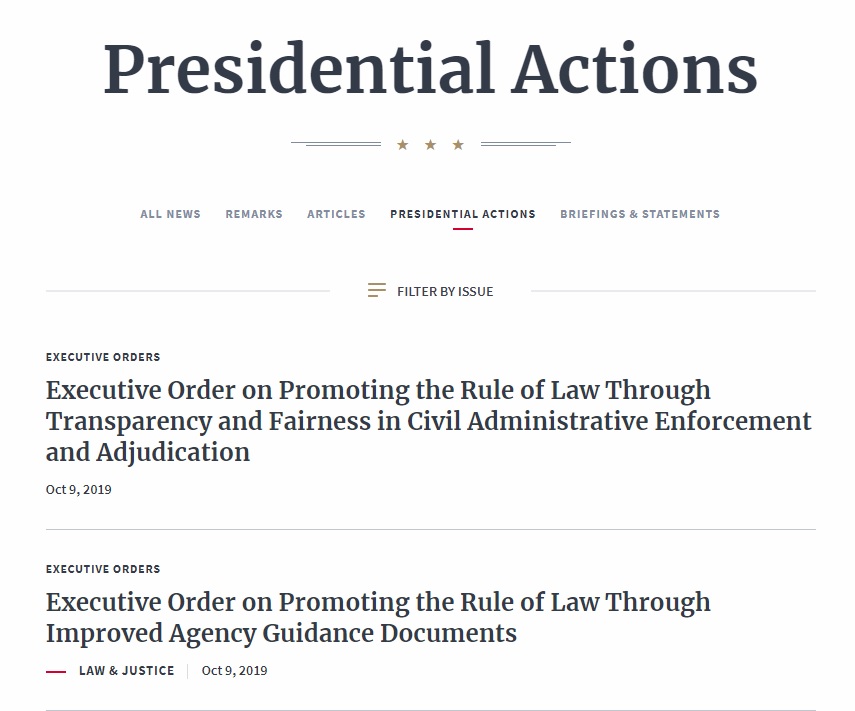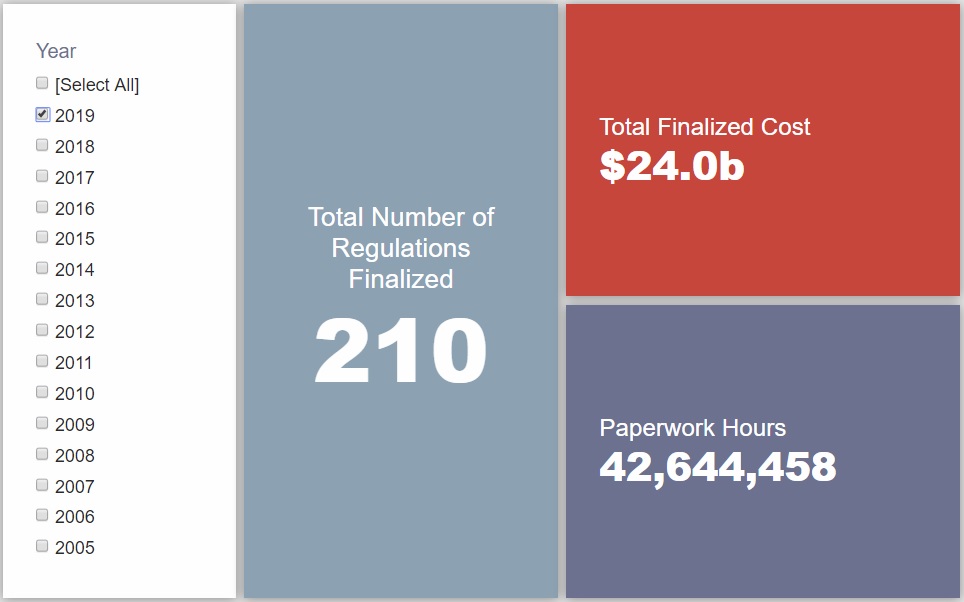Week in Regulation
October 15, 2019
More Impact from the Public Charge Rule
With the deadline of the 2019 regulatory budget year passed, this was a mostly quiet week for rulemaking, with the publishing of just 12 final or proposed rules with estimated costs or savings. A State Department rule changing how it will deal with visas in light of August’s public charge rule from the Department of Homeland Security (DHS) carried by far the most economic impact among final rules. Across all proposed and final rules, agencies published $114.6 million in total net costs and added more than 520,000 hours of annual paperwork.
REGULATORY TOPLINES
- New Proposed Rules: 49
- New Final Rules: 68
- 2019 Total Pages: 54,921
- 2019 Final Rule Costs: $24 Billion
- 2019 Proposed Rule Costs: -$2 Billion
TRACKING THE REGULATORY BUDGET
There were four final rules published this week that will count towards the fiscal year (FY) 2020 regulatory budget. Three of these were classified as deregulatory, though none had quantified cost savings. The regulatory action, a rule from the State Department implementing a new form for visa applicants stemming from DHS’s public charge rule, has an annual cost of $15.7 million. This cost will be borne by applicants in time spent filling out required information in a new form. Using the Office of Information and Regulatory Affairs method of calculating the impact of a rule over a perpetual time horizon at a 7 percent discount rate, that would accrue $224.8 million in total costs toward the FY 2020 regulatory budget.
The largest rule published this week was a proposed rule from the Environmental Protection Agency that would set generic Maximum Achievable Control Technology standards for ethylene production. It comes with a total estimated cost of $71.8 million. Since it is a proposed rule, however, this amount is not applied to the regulatory budget total. But since it was published just a week into FY 2020, there is a chance a finalized version of the rule that would count toward the budget if issued by the end of the fiscal year.
For FY 2020, agencies have finalized six deregulatory actions and three regulatory actions, totaling a net $290.2 million in costs. The Trump Administration has yet to release its regulatory budget goal for FY 2020, though it is expected soon.
THIS WEEK’S REGULATORY PICTURE
This week, President Trump issues two executive order reining in guidance document abuses.
On October 9, President Trump issued two executive orders aimed at addressing concerns that agencies sometimes use guidance documents as a way to shortcut the rulemaking process. These documents are supposed to be for informational purposes and to provide clarity; they are not supposed to be legally binding. Since guidance documents typically do not go through the public notice and comment process, they can be issued with little notice and no public input. Unfortunately, there have been instances where federal agencies have alleged violations against businesses and individuals for not doing what was demonstrated in a guidance document.
One of these orders, Promoting the Rule of Law Through Transparency and Fairness in Civil Administrative Enforcement and Adjudication, deals with penalties stemming from guidance documents and other unannounced policy interpretations. It prevents agencies from “unfair surprise” enforcement actions — primarily through citing violations of guidance documents — and provides anyone receiving a notice of violation more opportunities to contest potential violations.
The second, Promoting the Rule of Law Through Improved Agency Guidance Documents, increases transparency around guidance documents. It requires federal agencies to establish a repository page on their respective websites, where all of each agency’s guidance documents can be found. This repository will make it easier for someone to find guidance on a subject affecting their business. The executive order also states that any guidance document not found on the issuing agency’s website is considered no longer in effect. Further, the executive order requires agencies to make draft versions of new, major guidance available for public input at least 30 days before they are finalized.
Read more from the American Action Forum on this issue, including the implications of the executive orders, in a recent Insight.
TOTAL BURDENS
Since January 1, the federal government has published $22 billion in total net costs (with $24 billion in finalized costs) and 47.1 million hours of net annual paperwork burden increases (with 42.6 million coming from final rules). Click here for the latest Reg Rodeo findings.












